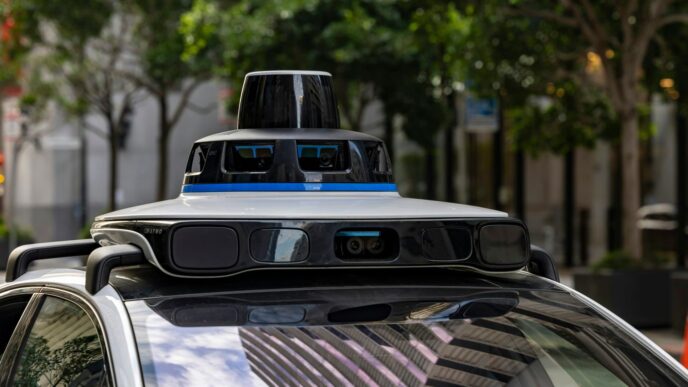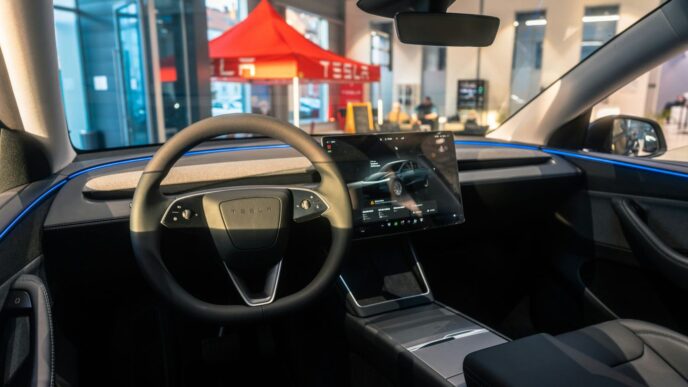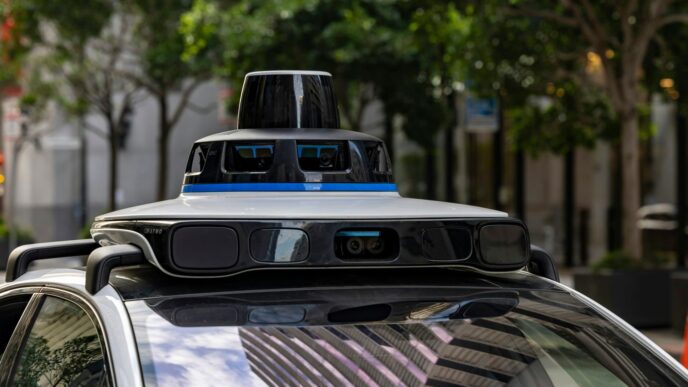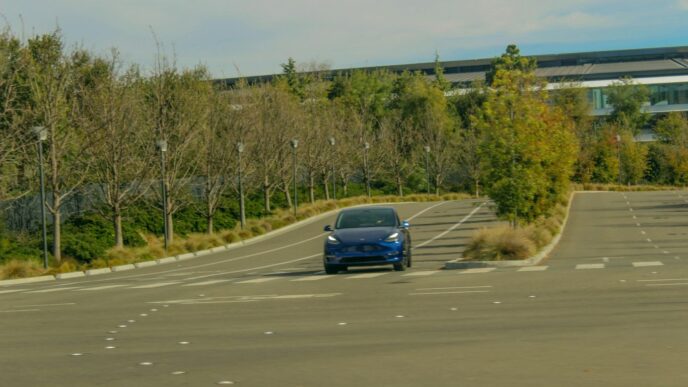Expanding the Waymo Partnership Ecosystem
Waymo isn’t just building self-driving cars in a vacuum. They’re actively building a whole network of partners to make their service work better and reach more people. It’s like putting together a really complicated puzzle, and each partner is a key piece.
Network Partners Driving Rider Access
Think about how you get a ride. Sometimes, Waymo teams up with existing ride-hailing services to get their autonomous vehicles in front of more riders. For example, in places like Austin and Atlanta, you can actually hail a Waymo ride through the Uber app. This is a smart move because it taps into a huge existing customer base without Waymo having to build everything from scratch. It’s all about making it easier for people to try out the service.
Fleet Partners Ensuring Operational Efficiency
Keeping a fleet of self-driving cars running smoothly is a big job. That’s where fleet partners come in. In the US, companies like Moove.io help with things like keeping the cars clean and making sure they’re ready to go. Over in Tokyo, Waymo is working with local companies like Nihon Kotsu and GO. These partners are not only helping manage the Waymo fleet but are also driving manually to map the city. This is super important for Waymo to figure out how to best operate on different international roads.
Integration Partners for Seamless Technology Adoption
Getting the Waymo Driver technology into the actual vehicles is another area where partnerships shine. Companies like Magna are working with Waymo to integrate the self-driving tech and even help assemble the vehicles that Waymo uses every day. This collaboration helps speed up the process of getting more autonomous vehicles on the road and ready for passengers.
Key Waymo Partnership Collaborations
Waymo isn’t doing this whole self-driving thing alone. They’ve teamed up with some pretty big names to make sure their technology is top-notch and ready for the real world. It’s all about building a solid foundation for the future of getting around.
Automotive Partners for Electric Vehicle Platforms
Getting the right vehicles is a big deal, right? Waymo is working with car manufacturers who are also focused on sustainability. These partnerships mean Waymo gets access to all-electric vehicle platforms, which are perfect for integrating their autonomous driving tech. It’s a win-win: Waymo gets the hardware they need, and these automakers get to be at the forefront of self-driving integration. Think of it as building the future of cars, together.
EV Charging Partners for Fleet Readiness
An electric fleet needs a lot of power. That’s where EV charging partners come in. These companies help make sure Waymo’s vehicles are always charged up and ready to go, day or night. It’s not the most glamorous part of the job, but it’s super important for keeping the service running smoothly. Without reliable charging, the whole operation would grind to a halt. They’re basically the pit crew for Waymo’s electric race cars.
Safety Research Partners for Validation
Safety is, like, the number one thing for Waymo. They’re not just taking their own word for it, though. Waymo partners with independent safety research groups to really put their technology through the wringer. They share their safety data and let these outside experts compare Waymo’s performance against human driving benchmarks. This kind of rigorous testing and validation is what builds trust. It shows they’re serious about making sure their driver is as safe as possible, maybe even safer.
Global Waymo Partnership Initiatives
Waymo isn’t just focused on making self-driving cars work in the US. They’re looking at how to bring this technology to different parts of the world, and that means working with local companies. It’s a big undertaking, and they know they can’t do it alone.
International Fleet Management in Tokyo
Getting Waymo’s cars to operate smoothly in a place like Tokyo is a whole different ballgame. The roads, the traffic rules, even how people drive – it’s all unique. That’s why Waymo has teamed up with Japanese companies like Nihon Kotsu and GO. These partners are helping Waymo manage their fleet on the ground. They’re also driving Waymo vehicles manually, which is a smart way to map out the city and understand its quirks. This hands-on approach is key to figuring out how Waymo’s technology can adapt to international roads and driving styles. It’s not just about the tech; it’s about understanding the local context.
Adapting to Global Roadways Through Partnerships
The goal is to make the Waymo Driver work safely and reliably everywhere, not just in familiar territory. This requires a deep dive into how different cultures approach driving and what makes each city tick. By partnering with local experts, Waymo can gather the specific data and insights needed. Think about it: mapping a dense urban area in Japan is vastly different from mapping Phoenix. These collaborations help Waymo learn and adjust its systems, making sure the Waymo Driver is prepared for whatever the world throws at it. It’s a step-by-step process, building on local knowledge to achieve a global vision for autonomous mobility.
Community and Safety in Waymo Partnerships

Waymo knows that bringing self-driving cars to everyone means working with the people who live and work in the communities where they operate. It’s not just about the tech; it’s about making sure everyone feels safe and included.
Community Partners for Inclusive Mobility
Waymo has teamed up with over 100 different community groups. These aren’t just random organizations; they represent a wide range of people with different needs and abilities. The goal here is pretty straightforward: build a future where getting around is safe and easy for absolutely everyone. Think about it – people with disabilities, seniors, parents with young kids – Waymo wants to make sure its service works for them. They’re actively listening to feedback and working with these groups to figure out how to make their service truly accessible.
Collaborating with Local Officials and Groups
It’s not just about community groups, though. Waymo also works closely with local government folks and public safety teams. They’ve held training sessions for thousands of first responders, like police and firefighters, across many different agencies. This is so these folks know what Waymo vehicles are and how to interact with them if they ever need to. This proactive approach helps build trust and ensures that emergency services are prepared. They’re also working with local officials to understand the unique needs of each city and how Waymo can best fit in.
Dori Saves Lives Partnership for Traffic Safety
Waymo has also partnered with organizations focused on traffic safety. One notable collaboration is with Dori Saves Lives. This partnership aims to educate the public about safe driving practices and the role of new technologies like autonomous vehicles in reducing accidents. By working with groups like this, Waymo is showing a commitment to a broader vision of road safety that goes beyond just their own technology. They’re sharing safety data and working with third-party researchers to compare their performance against human drivers, which is a pretty big deal for transparency.
Strategic Waymo Partnerships for Future Growth

Waymo isn’t just building self-driving cars; they’re building a future for mobility, and that means teaming up with some big names in the automotive world. It’s all about getting their technology into more vehicles and making autonomous driving a reality for more people.
Hyundai Partnership for Ioniq 5 Integration
Waymo is working with Hyundai, a major player in the car industry. The goal here is to get Waymo’s self-driving tech integrated into Hyundai’s electric vehicles, specifically the Ioniq 5. This isn’t just about putting a sticker on a car; it’s about deep integration, making sure the Waymo Driver works perfectly with the vehicle’s systems. This collaboration aims to bring advanced autonomous features to a wider range of electric vehicles. It’s a smart move to expand their reach beyond their own custom-built vehicles.
Toyota Collaboration on Autonomous Vehicle Platforms
Another huge partnership is with Toyota. This collaboration is looking at how Waymo’s technology can work with Toyota’s vehicle platforms. Think of it as exploring how to bring Waymo’s driving system to cars that many people already know and trust. They’re talking about how to make autonomous driving safer and more accessible, with a shared vision for reducing traffic accidents. It’s a long-term play to see how self-driving tech can fit into a company that makes so many cars.
Zeekr Vehicle Integration for Next-Generation Fleet
Waymo is also teaming up with Zeekr, an electric vehicle brand. This partnership is focused on integrating Waymo’s autonomous driving system into Zeekr’s next-generation vehicles. This means Waymo’s technology will be built into cars designed from the ground up for autonomous driving. It’s about creating a fleet that’s ready for the future, with vehicles that are optimized for Waymo’s Driver. This kind of integration is key to scaling up their operations and making their service more efficient.
Waymo Partnership Milestones and Evolution
Waymo’s journey to becoming a leader in autonomous driving hasn’t happened overnight. It’s a story built on steady progress and smart collaborations. Think of it like building something complex; you need to lay a solid foundation, test things out, and then gradually expand. That’s pretty much what Waymo has done with its partnerships.
Early Rider Program and Feedback Integration
Back in 2017, Waymo kicked off its Early Rider Program in Arizona. This wasn’t just about testing the tech; it was about getting real people to use it and tell them what they thought. This feedback loop was super important for shaping the service. Imagine being one of the first people to regularly ride in a self-driving car – you’d have a lot of opinions, right? Waymo actively listened to these early users, using their experiences to tweak the ride experience, improve how the car handled different situations, and generally make the service better for everyone.
Launch of Waymo One Commercial Service
Fast forward to 2018, and Waymo took a big leap by launching Waymo One in Phoenix. This was the world’s first commercial self-driving ride-hailing service. It wasn’t just a pilot program anymore; it was a real service available to the public. They started with the Chrysler Pacifica Hybrid minivans, which were the first vehicles specifically built to work with the Waymo Driver. This launch marked a significant shift from testing to actual deployment, showing that the technology was ready for everyday use.
Expansion into New Cities Through Partnerships
Waymo didn’t stop at Phoenix. To grow and reach more people, they’ve relied on partnerships. For instance, in cities like Austin and Atlanta, you can now hail a Waymo ride through the Uber app. This kind of partnership is a smart way to tap into an existing rider base and infrastructure without having to build everything from scratch. It’s about working with others to make autonomous rides accessible in more places, faster than they could alone.
Wrapping It Up
So, what does all this mean? Waymo’s partnerships are really showing how they plan to get their self-driving cars out there. It’s not just about building the tech; it’s about working with others to make it happen, whether that’s putting their cars on Uber’s app, teaming up with car makers, or even getting help with charging. They’re clearly trying to cover all the bases to make this whole autonomous driving thing a reality for more people, in more places. It’s a big undertaking, and these collaborations seem like the key to making it work on a larger scale.














